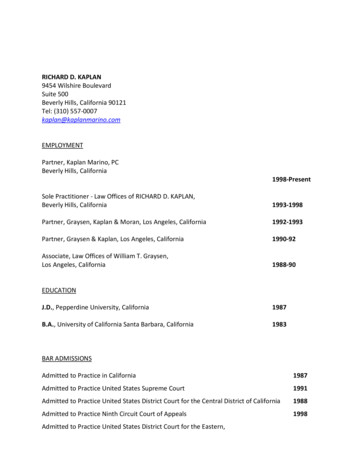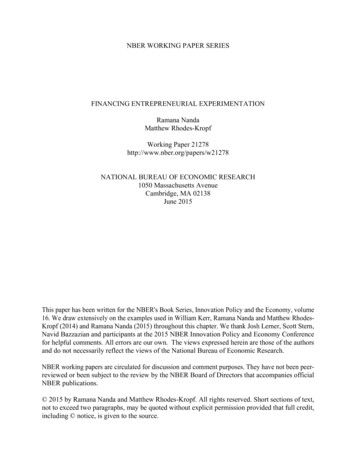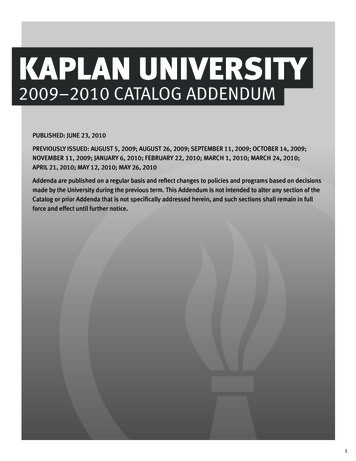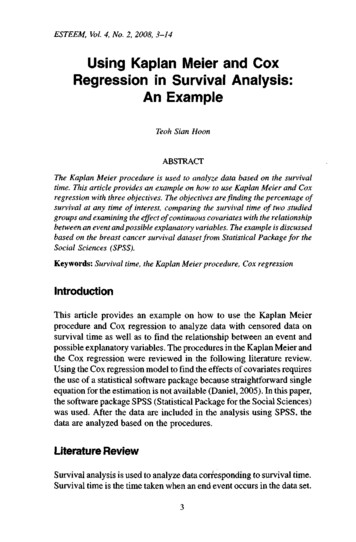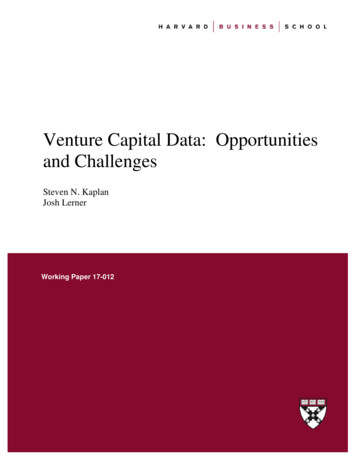
Transcription
Venture Capital Data: Opportunitiesand ChallengesSteven N. KaplanJosh LernerWorking Paper 17-012
Venture Capital Data: Opportunities andChallengesSteven N. KaplanUniversity of Chicago Booth School of BusinessJosh LernerHarvard Business SchoolWorking Paper 17-012Copyright 2016 by Steven N. Kaplan and Josh LernerWorking papers are in draft form. This working paper is distributed for purposes of comment and discussion only. It maynot be reproduced without permission of the copyright holder. Copies of working papers are available from the author.
Venture Capital Data: Opportunities and ChallengesbySteven N. Kaplan* and Josh Lerner**August 2016Forthcoming in Measuring Entrepreneurial Businesses: Current Knowledge and Challenges(John Haltiwanger, Erik Hurst, Javier Miranda, and Antoinette Schoar, editors), Chicago,University of Chicago Press for National Bureau of Economic Research.AbstractThis paper describes the available data and research on venture capital investments andperformance. We comment on the challenges inherent in those data and research as well aspossible opportunities to do better.*University of Chicago Booth School of Business and NBER, and **Harvard Business School and NBER. Thispaper was prepared for the NBER-CRIW Conference on Measuring Entrepreneurial Businesses: Current Knowledgeand Challenges. We thank Rick Townsend for very helpful comments. Kaplan and Lerner have consulted toventure capital general partners and limited partners and have invested in venture capital funds. Lerner thanksHarvard Business School’s Division of Research for support. Kaplan thanks the Fama-Miller Center at ChicagoBooth. Address correspondence to Steve Kaplan, University of Chicago Booth School of Business,skaplan@uchicago.edu and Josh Lerner, Harvard Business School, josh@hbs.edu. All errors and omissions are ourown.
I.IntroductionVenture capital is a relatively small financial institution. In the five years from 2009 to2013, the NVCA – National Venture Capital Association (2014) –reports that an average offewer than 1,200 firms received venture capital for the first time annually in the U.S. This is avery small fraction – roughly one in 500 or 0.2% – of the 600,000 firms (with employees) thatare started each year (U.S. SBA (2012)). Over the same five-year period, U.S. venture capitalpartnerships received an average of less than 18 billion in new capital commitments frominvestors each year. And these figures are for the U.S., by far the largest market for venturecapital in the world.So why then does venture capital receive a large amount of theoretical, empirical, policyand media interest? From a theoretical perspective, venture capital is particularly interestingbecause it encompasses the extremes of many corporate finance challenges: uncertainty,information asymmetry and asset intangibility. At the same time, from an empirical and policyperspective, venture capital has had a disproportionate impact. Kortum and Lerner (2000) findthat venture capital is three to four times more powerful than corporate R&D as a spur toinnovation. Kaplan and Lerner (2009) find that roughly 50% of the “entrepreneurial” IPOs inrecent years are venture-backed despite the fact that only 0.2% of all firms receive venturefunding.But despite the extent of interest in venture capital, substantial misunderstandings aboutthis intermediary persist. This is particularly true in policy circles, which have seen the launch ofill-considered efforts to promote venture activity in many geographies (see Lerner (2009)), andmedia discussions. This reflects the facts that venture capital is a form of private equity, and thataspect of private equity is that it is indeed private. Unlike mutual funds, venture capitalists are
typically exempt from the Investment Company Act of Act of 1940, and typically do not disclosemuch information to the United States Securities and Exchange Commission or other regulators.This has led to a shortage of reliable industry data and to an unappealing setting where industryadvocates make sweeping claims about the benefits and critics make broad charges on veryshaky empirical foundations.This lack of a comprehensive dataset has also posed challenges to academic research.One of the most important ways that academic research in the social sciences proceeds is byresearchers replicating and exploring the limitations of earlier studies. Instead, in venturecapital, because the studies often rely on proprietary datasets that are not shared more generally,studies are difficult to replicate or refute. Another unappealing consequence is that dubious ormisleading studies can linger for many years without rebuttal.Sadly, this problem may be getting worse, rather than better. The past decade has seen ofthe rise of “individualized entrepreneurial finance”: angels, groups of angels, crowdfundingplatforms, and the like. While venture capital remains concentrated in a few metropolitan areas,mostly in the United States, the amount of angel investments appear to be increasing in manynations (Wilson and Silva, 2013). Active involvement in the investment and close social tiesbetween angels and entrepreneurs may help to overcome the lack of minority shareholder andlegal protections that are important for the development of more institutionalized capital markets.These investors are typically very reluctant to share information about their activities, both forstrategic reasons as well as due to a reluctance of personal exposure.In this paper, we describe the available data and research on venture capital investmentsand performance. As we do so, we comment on the challenges inherent in those data andresearch as well as possible opportunities to do better. We begin by describing the data and
research on investments by venture capital funds in portfolio companies. We follow that bydescribing the data and research on investments (by institutional investors and wealthyindividuals) in the venture capital funds.II.Investment Data and ResearchA.Longstanding databasesMuch of the early research into venture capital relied on information available in IPOprospectuses and S-1 registration statements. For the subset of venture-backed firms thateventually go public, voluminous information is available. Investments in firms that do not gopublic are more difficult to uncover, since these investments are usually not publicized.Unfortunately, because only a relatively modest fraction of venture-backed companies go public,researchers must dig deeper.There are two longstanding databases that characterize the investments of venture capitalfunds into portfolio companies, regardless of the investment outcome. VentureXpert (VX), aunit of Thomson Reuters, began collecting data in 1961. Venture Source (VS), a unit of DowJones, began collecting data in 1994.The basic story here is that there are large inconsistencies in both databases and a generalproblem of incompleteness. Furthermore, qualitatively, both show deterioration in data qualityover the past decade. That said, VX has more complete coverage of investments while VSmeasures outcomes more accurately.Maats et al. (2011) focus on investments by 40 VC funds with vintage years 1993 to2003. They obtain data about the investments and exits from outside sources and, for two VCfunds, from a major limited partner. They then compare the actual data to the data in VS and
VX. This follows and expands on an earlier iteration of this research design by Kaplan, Sensoyand Stromberg (2002).First, they find that VX has more complete coverage of the investments in the funds.Second, they find that both VX and VS understate the fraction of companies that are defunct,with VX having more incorrect. In fact, VX reports less than 10% of investments as defunctwhen, in fact, more than 20% are defunct. Third, VX exit / status coverage has droppeddramatically in recent years suggesting a lack of investment in collecting new data.Maats et al. (2011) then do a firm level comparison for 449 venture-financed firms thatare in both VX and VS. Figure 1 shows that VX appears to have somewhat better coverage. VXhas 40% more financing rounds. While VX and VS have post-money valuations for roughly thesame number of firms, VX has roughly 10% more post-money valuations for financing rounds.Figure 2 provides a round-level comparison for 173 firms that are in both VS and VX. Again,VX has roughly 40% more rounds and roughly 10% more post-money valuations.Maats et al. (2011) also compare the accuracy of the two databases for two specific fundswhere they obtain data from a limited partner investor in the two funds. VX does a much betterjob of including firms in the database that the funds actually invested in. The funds that VSexcludes tend to be predominantly funds that failed, leading to a likely upward performance biasin VS.The earlier comparison by Kaplan et al. (2002) had suggested some valuation advantagesfor VS. They compared the actual valuations in 143 financings to their reported values in VSand VX (prior to 2000). They found that VS included almost twice as many valuations as VXand the average absolute error of those valuations was only 60% of those in VX.
There is an important additional caveat in measuring valuations. They do not reflect theimpact of transaction terms, instead simply reporting the “pre” or “most-money” valuation,which are defined as the product of the nominal price per share paid in transaction times thenumber of shares outstanding (typically, assuming all shares are converted into common stock)before and after the transaction. In other words, these calculations ignore the implicit call andput options associated with these securities. See Kaplan and Stromberg (2003) for a catalog ofthese features.Liquidation preferences, in particular, can have a large impact on values. Metrick andYasuda (2010) provide examples where valuations change by 75% when deal terms are properlyanalyzed. To correctly analyze valuations across different investments, it is necessary to haveaccess to the actual deal terms. This requires access to the underlying deal documents which arenot easy to obtain.There is one other difficulty in both databases – firm name changes. Both databases onlyindex on the current (or latest) portfolio company name. The recording of former names isdesultory at best. Of course, this makes matching to historical records challenging.Finally, the results in Maats et al. (2011)—as well as anecdotal accounts—suggest thatthere has been substantial subsequent deterioration in the quality of both databases. In particular,the initial focus by VS on valuations seems to have been largely abandoned. In part, this mayreflect the challenges associated with the reliance on commercial data providers, who may decideon an investment in ensuring data quality that while profit-maximizing, is less than an academicfinancial economist would prefer.B.More recent alternatives
There are a number of recent alternatives to VX and VS. Several databases that focus ontracking private equity (buyout) funds and transactions also include some VC funds and deals.These databases are typically based on disclosures from limited partners, filings with the SEC,and other public (but often difficult to access) sources. Examples include Capital IQ, Pitchbookand Preqin. VCExperts is a newer database that specializes in VC deals and is sourced fromstate and federal regulatory filings by private companies.The SEC maintains Form D filings of private financings, but these provide only theamount of funding and not the names of investors.There are some websites that track venture capital financings. Tech Crunch’s,Crunchbase, is the best known. While many of these newer databases are promising, they havenot gotten the kind of scrutiny that VS and VX have. Thus, their ability to support academicresearch is still to be fully determined.C.The bottom line on portfolio company dataAs mentioned above, the basic story on portfolio company data is not a great one. Thereare large inconsistencies in the two major existing databases, VX and VS, and a general problemof incompleteness. Furthermore, qualitatively, both show deterioration in data quality over thepast decade. As we will discuss in the conclusion, there is an opportunity for a new provider—whether for-profit or non-profit – to significantly improve on these data.It also seems possible that the fund performance data providers described in the nextsection, particularly Burgiss, Cambridge Associates and Preqin will be able to augment theirfund data with data on individual portfolio companies.
III.Performance dataThere are currently three major providers of data on VC (and private equity) performance– Burgiss Private I, Cambridge Associates (CA) and Preqin. Pitchbook is a fourth newer entrantwith more of a focus on private equity performance. Until recently, there was a fifth, ThomsonVenture Economics (TVE). For reasons likely related to poor quality data that we describebelow, TVE decided to discontinue its database and, instead, make CA available on TVE’splatform.As with the data on VC firm investments in portfolio companies, VC fund performancedata are also potentially subject to biases: First, the data from any one provider may be incomplete. For instance, a number ofleading venture capital funds have pressured pension funds not to post on-line or to reporttheir performance to data providers such as Preqin. Some have gone as far as to dropinstitutions that cannot make such commitments as limited partners (Lerner, et al.(2011)). Given the highly skewed nature of performance in venture capital, even ahandful of omissions can have a substantial impact on reported performance figures. Second, it is possible there is a backfill bias in that the databases report positive pastreturns for funds that are newly added to the database. Many first-time funds do not haveany institutional investors, and may not be captured by commercial data providers unlessthey successfully raise a second fund. Third, to the extent that the databases rely on data directly reported by the GPs, it ispossible that poorly performing funds stop reporting or never report at all. Fourth, to the extent that database providers rely on information from GPs—or the LPsreport data from GPs without adjustment—the quality of the information can suffer from
deliberate distortions of the valuations. One example is the valuation of still privatelycompanies in the venture capitalists’ portfolios. Particularly with early stage companies,valuations assigned by venture firms to their own portfolio of investments are often basednot on quantitative metrics (such as price-to-earnings or discounted cash flow) becausethe company may not have any prior earnings or reliable projections. Instead, thepartners rely on complex, frequently subjective assessments of a venture’s technology,expected market opportunity, and its management team’s prowess. Less establishedgroups, or those seeking to raise new funds in the near future, may be tempted to shadethese valuations upwards. Similar concerns have been raised by stock distributions toLPs, a technique often employed by venture funds to unwind large positions in recentlypublic (and often thinly traded) firms. While venture groups may value thesedistributions at the price prior to the distribution, the sales that ensue after the distributionoften mean that the realized price is substantially lower. Again, because many LPs do notadjust the GPs’ data, these inflated valuations may find their way into databases. Finally, the commercial platforms use different data definitions that complicate crossplatform comparisons. For example, funds are generally grouped by vintage year – theyear they began. However the different platforms define beginning differently. Burgissgroups funds by the year in which the year the fund first takes down money frominvestors. CA groups funds by the year the fund is legally formed. Preqin groups fundsby the year the fund makes its first investment in a company. While these threedefinitions will often coincide, they do not always do so.In addition, some funds not only make investments in venture capital / early stagecompanies, but also in growth stage companies and in buyouts. Indeed, it is frequently difficult
to define where early-stage investing ends and later-stage transactions begin. While traditionalbuyout groups such as TPG have increasingly taken part in the later rounds of social mediacompanies, many venture funds have undertaken growth investments in traditionalmanufacturing firms in markets such as India and China. In some cases, one commercialplatform will classify a multi-asset class investor as a VC fund while a different platform willclassify the same investor as a buyout fund.In the rest of this section, we describe the coverage of the major platforms and theiradvantages and disadvantages.A.CoverageFigure 3 presents data on fund coverage by four of the commercial platforms as of thefirst quarter of 2011 using data from Harris et al. (2014). TVE had the highest number of fundsin the 1980s and the 1990s. In the 2000s, however, TVE declined to the lowest coverage withPreqin and CA moving to the highest number of funds represented. Though not illustrated in thegraphs above, Burgiss had increased its representation for the most recent vintage years, 2006 to2008, to roughly the same coverage as Preqin and CA. In its most recent release, the secondquarter of 2014, Burgiss’ coverage had increased markedly to 538 VC funds with vintage yearsfrom 2000 to 2008, up from the 423 funds in 2011.Figure 4 presents total capital commitments represented in the commercial platforms as aproportion of total capital committed to VC, using the data in Harris et al. (2014) as of 2011 Q1.Total committed capital is taken from the annual totals provided by the Private Equity Analyst.Burgiss and Preqin have a higher proportion of total commitments from 2000 to 2008.Capital commitments for CA funds were not available for the study.
As with the number of funds, TVE had strong coverage in the 1980s and 1990s with over100% of committed capital in the 1980s and almost 80% in the 1990s. In the 2000s, TVEdropped off. Preqin had performance data on funds with roughly 70% of committed capital;Burgiss performance data on funds with 60% of committed capital.In its most recent release, 2014 Q2, Burgiss has coverage of 72% of committed capitalfor 2000 to 2008 vintages. Its coverage reaches 89% of committed capital for vintages from2006 to 2013.B.Commercial platforms1.Burgiss OverviewThe data are derived from LPs for whom Burgiss’ systems provide record-keeping andperformance monitoring services. The Burgiss data are sourced exclusively from a diverse arrayof LPs for whom Burgiss provides record-keeping and performance monitoring services. Thisincludes a complete transactional and valuation history between the LPs and fund investments.As a result, Burgiss is able to record exact cash outflows / investments made by LPs to GPs anddistributions from GPs back to LPs. Burgiss also cross-checks across investors in the same fund.This feature results in investment histories that are free from any reporting bias. For instance,Burgiss has the complete investment history of LPs who allow Burgiss to aggregate their data.In addition, the Burgiss data are current because Burgiss’ LPs receive their data currently fromGPs and Burgiss uses the quarterly reporting used by most investors.Harris et al. (2014) report that their data come from over 200 institutional investorsrepresenting over 1 trillion in committed capital. Two-third of the LPs have PE commitments
of over 100 million. Of these 60% are public/private pensions and 20% are endowments orfoundations.Over time, the number of funds in the Burgiss database has increased as Burgiss hasgained permission to access the investment performance of an increasing number of LPs. Theone potential bias in the Burgiss data is that the LPs who allow access are selected. In particular,it is possible that the LPs who allow access, as a group, have tended to invest in above averagefunds and, therefore, exclude some below average funds. For this bias to be in the data,however: (1) there would have to be a group of institutional investors who invested in the worstVC funds, had poor performance, and do not use Burgiss to measure their fund performance; (2)no other institutional investors who do use Burgiss invested in those same VC funds, so thepoorly performing PE funds do not show up in the data set. Given the size of the Burgiss dataset, this seems unlikely. Furthermore, the fact that Burgiss covers almost 90% of the total capitalcommitted to venture capital in post-2005 vintages suggests that this bias, even if it were to exist,is likely to be small for those vintages.2.PreqinPreqin’s performance data are sourced primarily from public filings by pension funds,from FOIA requests to public pension funds, and voluntarily from GPs (about 60% ofperformance data) and LPs.Preqin (and Pitchbook) are the only major data sources that identify GPs by fund nameThis means that the Preqin data are transparent and can be verified / corrected. The authorsknow GPs who have voluntarily contacted Preqin to correct erroneous data for their funds.
At the same time, Preqin has at least three potential biases. First, Preqin may miss somehigh performing funds that do not have public pension fund investors or have reportingrestrictions. Notably, Preqin does not have performance data for a number of funds raised byvery high performing VC’s like Sequoia and Accel.Second, because Preqin relies on voluntary reporting, Preqin often has somewhat staledata because of tardy responses.Third, Preqin reports performance for a number of funds for which it does not have thegranular cash flow data. In other words, some LPs simply report IRRs and multiples withoutreporting the cash flows that generated them.3.Cambridge Associates (CA)CA sources its data from voluntary disclosures by LPs and by GPs who have raised or aretrying to raise capital. Because GPs typically do not try to raise a new fund if their performanceis poor, CA may have a bias towards successful GPs. Also favoring this bias is CA’s traditionalorientation to providing services to endowments, who appear to have (historically at least)selected the most successfully venture capital LPs with which to invest (Lerner, et al. (2007)).Whatever its other strengths and weaknesses, CA also is the least transparent of thecommercial platforms.4.Thomson Venture Economics (TVE)TVE has traditionally sourced its data from both LPs and GPs in a manner similar to thatused by CA. The major issue with TVE was that it appeared to stop updating performance onroughly 40% of the venture capital and private equity funds in the VE sample. Stucke (2011)
finds that of 488 buyout funds with 1980-2005 vintage years, 43% have constant NAVs and nocash flow activity for at least two years prior to December 2009. Phalippou and Gottschalg(2009) find that 300 of 852 sample funds are inactive for over 3 years, with most for 6 years.Stucke (2011) compares the performance of individual buyout funds in TVE to the actualperformance of those funds provided by a large LP in those funds. He finds a substantialdownward bias in the TVE data. While he does not study VC funds, it seems likely that the VCperformance data had a similar downward bias.Consistent with such a downward bias, Harris et al. (2014) find that VC fundperformance in the TVE data is lower than that in Burgiss, CA and Preqin. Also stronglyconsistent with data problems, in March 2014, TVE decided to discontinue its benchmark dataand, instead, contracted with CA to provide CA’s private equity benchmarking data to TVEsubscribers. 1C.Performance resultsHarris et al. (2014) present VC (and PE) performance data from the major commercialdatabases as of the first quarter of 2011. Harris et al. (2015) present performance data updatedto the second quarter of 2015. They find that venture capital (VC) funds outperformed publicmarkets (as measured by the S&P 500) substantially until the vintages of the late 1990s.Coinciding to some extent with the tech bust, vintages from 1999 to 2003 underperformed publicmarkets. Vintages from 2004 to 2010 have rebounded, performing better than or equal to publicmarkets. That performance has likely further improved since then. This performance contrasts1See, “Thomson Reuters partners with Cambridge Associates on benchmark data,” March ata/.
with the view held by some that VC has been a poorly performing asset class as a whole in thiscentury.Harris et al. (2014) also find that Burgiss, Cambridge Associates and Preqin yieldqualitatively and quantitatively similar performance results. Tables 1a and b reproduce theseresults from Harris et al. (2014). There is little reason to believe that the Burgiss and Preqin datasets, in particular, suffer from performance selection biases in the same direction. At the sametime, consistent with Stucke (working paper 2011), they find that performance is lower in theVenture Economics data (particularly for buyout funds).Kaplan and Sensoy (forthcoming) provide a broader summary of the performance of PEand VC funds. Other research is broadly consistent with the results in Harris et al. (2014 and2015).D.The bottom line on performance providersBased on the research done to date, Burgiss is likely the best of the commercial dataproviders. The data it has are current and do not appear to be selected. Given the similar resultsin Preqin and CA, it is unlikely there is any appreciable bias across these databases. The fact thatBurgiss now covers performance for almost 90% of the total capital committed to venture capitalin post-2005 vintages suggests that the ability to do research on venture capital funds willcontinue to improve over time. This is particularly encouraging given that Burgiss makes itsdata available to researchers through proposals to the PERC (Private Equity ResearchConsortium). Kaplan serves on PERC’s academic advisory board.
While Preqin (and Pitchbook) have potential selection biases, they are also powerful andvaluable because they identify the performance of individual funds. This allows a better fix onthe potential selection biases at work.Thomson Venture Economics (TVE) should not be used. Its database has beendiscontinued. Results in past work using TVE should be with viewed with caution.It is also worth noting that this is a dynamic field, with a number of new entrants.Examples include eFront and State Street Bank, which have gathered data as part of their workwith general and limited partners, and analytics solutions providers such as Bison. While it isstill early to evaluate many of these efforts, the promise of more and higher quality data augurswell for future research opportunities.A “horse of a different color” is the Private Capital Research Institute, in which both ofthe authors are involved (Kaplan as an academic advisory board member and Lerner as director).This foundation-supported non-profit is in the process of developing an database exclusively foracademic research, modelled after the architecture for compiling confidential informationemployed by the U.S. government. By restricting the data use to these applications, it is hopedthat a broader swath of the industry will consent to the utilization of their data.The heart of the PCRI effort is high quality data about private capital investments. Whilecommercial data vendors typically piece this together from a variety of sources, includingsecurity filings and disclosure statements by institutional investors, frequently the information isincomplete and inconsistent.The vision of the PCRI is to focus very much on obtaining data from the private equityfirms themselves. To date, over 40 of the 100 largest private equity firms world-wide haveprovided data to the PCRI, or are in the process of doing so. It might be plausibly wondered why
private equity firms would be willing to share data with the PCRI when the commercialdatabases have often struggled to get data from these institutions. The answers are several:1) The constraints the PCRI places on the use of the data. In particular, the PCRI isdesigned to be a project run by academics and for academics. The information isused exclusively for academic research, rather than for any commercial purpose.2) The research protocol simultaneously allows academics to undertake high-qualityresearch while protecting the confidentiality of the data being provided by the privateequity firms. In particular, following the model employed by the United StatesBureau of the Census when making available information that it and the United StatesInternal Revenue Service collect, academics can undertake detailed cross-tabulatedanalyses but not download or view individual data entries. Essentially the academicswould be able to upload queries and download results without “touching” theindividual data entries.3) A third reason for the success of the PCRI in generating participation in the privateequity community has to do with the fact that the industry itself is under much greaterscrutiny. In particular, in the aftermath of the financial crisis there has been muchgreater attention to institutions such as hedge funds and private capital groups thattraditionally were exempt from most regulatory oversight in the United States andEurope. As a result of these pressures, industry leaders have increasingly appreciatedthe need for high quality independent research.Gathering information from the private equity firms has limitations. Even if every activegroup chose to participate, there would still be a number of groups that have gone out ofbusiness. As a result, the PCR
Steven N. Kaplan University of Chicago Booth School of Business . Josh Lerner . . See Kaplan and Stromberg (2003) for a catalog of these features. Liquidation preferences, in particular, can have a large impact on values. . Of course, this makes matching to historical records challenging. Finally, the results in Maats et al. (2011)—as .




